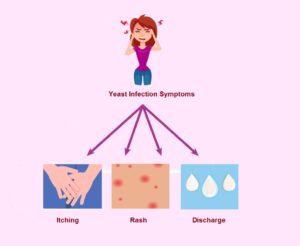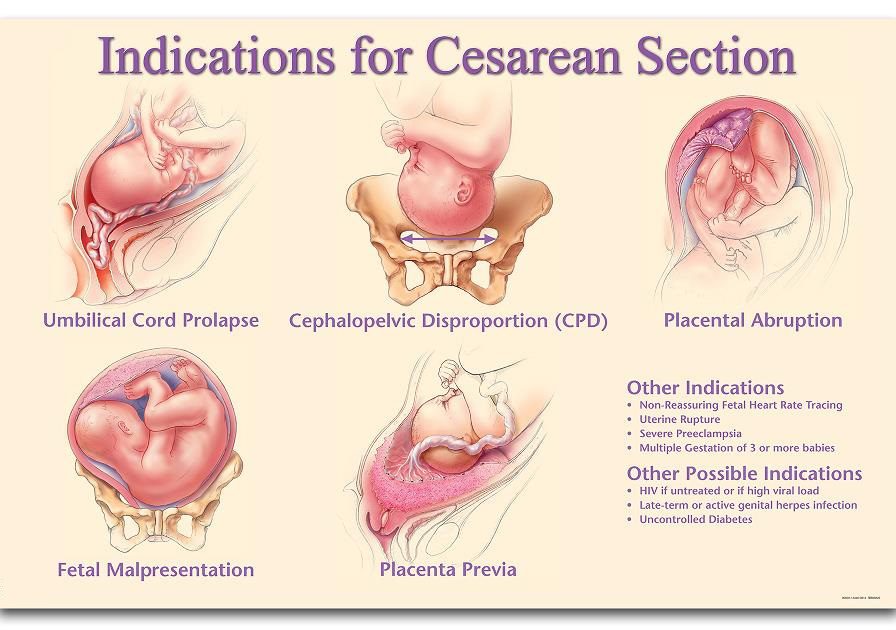What are Cesarean Sections?
Cesarean sections are surgical procedures in which the uterus is cut open and the baby delivered through the incision. It is also called a C-section.
What are the different types of Cesarean Sections?
Cesarean sections may be described :
- According to the site of the incision made on the abdomen.
- According to whether it is a planned or an emergency C-section.
Types of C-sections according to the site of the incision

Lower Abdomen Paramedian Incision – This type of incision, also called an up-and-down incision can extend from below the belly button to the pubic symphysis. In most cases, it begins about 2-3 inches below the umbilicus and about 2- 5 cms away from the midline of the abdomen. The midline is identified by the thin dark line which extends downwards from the umbilicus to the pubis. It then extends down to end a few centimeters above the pubic symphysis.
This type of incisions provide very good access to the structures of the lower abdomen like the uterus, ovaries, small intestine, colon, parts of the large intestine, rectum etc.
Pfannenstiel incision – This is a type of transverse (horizontal) skin incision placed about 1 inch above the symphysis pubis and along the hairline of the mons pubis. It ends about 3 cms from the anterior superior iliac spine (ASIS) .
This cesarean incision provides good access to the lower abdomen with less bleeding and less postoperative complications like pain. It also provides a good strong scar which is practically invisible. Since it is placed very low on the abdomen, it produces superior cosmetic result.
Cesarean Sections can also be Planned or Unplanned procedures.
– Planned cesareans are done when the doctor believes that a normal delivery may put the mother and /or the baby at risk of injury or may be fatal to either of them.
– Unplanned Cesarean sections are performed when complications arise when the woman is in labor, either with the fetus or the mother, and the baby needs to be delivered as early as possible.
What are the different categories of Cesarean sections?
The category depends on how urgently the Cesarean section needs to be done:
Category 1 – Women in acute emergency fall in this category. The type of C-section needs to be carried out within 30 minutes of diagnosis, ideally within 15 minutes. Some indications are acute fetal risk, heavy maternal bleeding, cord prolapse and risk of rupture of the uterus.
Category 2 – Cesarean sections in this category need to be done within 30 minutes to 60 minutes. Although these women are not an acute emergency, the surgery should be done as early as possible.
Category 3 – In this category, the need for immediate surgery is not present. But since the woman is in active labor and acute risks may occur at any time, surgeries in this category still need to be done as early as possible
Category 4 – There is no urgency in this category. The cesarean section is planned at a scheduled time and is done when the fetus is mature, usually after the 38th week of pregnancy.
The first 3 categories are considered unplanned surgeries while category 4 is a planned cesarean section.
How many layers are cut during a cesarean section?
During a cesarean section, the abdomen is cut in seven layers:
– Skin
– Subcutaneous fat ( fat under the skin)
– Rectus sheath – a thick membrane over the rectus muscles in the abdominal wall
– The Rectus abdominis muscle – this muscle is split along its fibers, rather than cut.
– The parietal peritoneum – a thin membrane over the abdominal organs
– The visceral peritoneum – this is a loose membrane over the lower part of the uterus
– The uterus. The layers of the uterus consists of the serosal outer muscle layer (perimetrium), the thick middle muscle layer (myometrium), and the inner mucosal layer (endometrium). All three layers are incised .
What are some reasons for a Cesarean section? Why is it done?
A cesarean section is done when a normal childbirth increases the risks of mortality or morbidity in the baby or the mother. Some of the common causes are:
- Failure of labor to progress. Normal labor lasts for about 12 hours in a woman in her first pregnancy and 8-10 hours in women with more children.
- Cephalo-pelvic Disproportion (CPD) – this is a condition when the baby’s head (cephalus) is larger than the mother’s pelvis, or because the mother’s pelvis is deformed.
- Fetal Distress
- Malpresentations of the baby, like breech or face presentation
- Multiple pregnancies, such as twins or triplets
- Previous bad obstetric history like neonatal death
- Previous multiple cesarean sections
- Prolapse of the umbilical cord or the hand or the foot.
- Low-lying placenta (placenta previa)
- Obstruction in the genital tract like tumors in the cervix or cancer of the cervix
- History of uterine rupture or surgeries in the uterus
- Conditions which contra-indicate normal child birth like cardiac or pulmonary disease
- Infections like active herpes simplex or HIV.
- Sometimes, a cesarean section may be done due to maternal request.
Procedure of Cesarean section – How is the surgery done?
Before the surgery, a catheter is placed to drain the bladder – this helps make the procedure easier.
An intravenous (IV) line will be started in the arm to maintain fluid input and for easier injection of medicines.
Anesthesia will be given – usually an epidural or spinal anesthesia. Sometimes, general anesthesia may be necessary.
The abdomen is then cleaned with antiseptic solutions and covered with sterile drapes to prevent infection.
An incision is made on the skin. This incision may be a midline up and down incision or a low transverse incision. The subcutaneous fat is cut, ligation or cauterization all the blood vessels are done to prevent bleeding. The rectus sheath, a tough membrane over the rectus muscles, is cut. The rectus muscles are then carefully split to allow access to the peritoneum.
The peritoneum is a thin membrane and it is opened to allow entrance into the abdominal cavity.
The lower segment of the uterus is covered by the thin visceral peritoneum which is cut to reveal the uterus. The uterus is incised. This opens the uterine cavity and the amniotic sac is reveled.
The amniotic sac is opened and the baby carefully delivered though the opening.
The cord is clamped and the baby handed over to the pediatrician.
The placenta is detached from the wall of the uterus and removed.
The inner walls of the uterus are inspected for bleeding and the muscles of the uterus are then closed in two layers.
The peritoneum is closed and the split rectus muscles replaced. In some cases, small stitches may be placed to align them in the former position.
The rectus sheath is stitched followed by stitches in the subcutaneous fat to close any gap between the sheath and the skin.
The two edges of the skin are then stitched with dissolvable sutures or stapled or glued together.

What happens after a C-section?
Once the c section is completed, the patient is shifted to the observation room and kept under close observation until she recovers fully from the anesthesia. She is allowed to hold and breastfeed the baby at this time.
A liquid diet and fluids are allowed to be taken once her intestinal movements normalize.
How long does a cesarean section take? Can the woman be awake through the procedure?
A standard cesarean section takes between 30 – 40 minutes.
In most cases, a spinal or Epidural anesthesia is given, numbing the body from the waist down. So, the woman can remain awake through the procedure and hold her baby immediately after the delivery. There is also no effect on the cardiac and respiratory systems of the mother. The baby too receives no anesthetic drugs through the mother’s blood. So, an epidural anesthesia is safer than a general anesthesia.
In some cases, a general anesthesia may be required. In this case, the anesthetic drugs make the woman unconscious and she is helped to breathe through an endotracheal tube in the respiratory system. The woman is not aware of the procedure at all.
What are the risks of a Cesarean Section?
A cesarean section is usually safe and in most cases, there is complete recovery. But it can carry some risks:
- Infection in the incision line of the uterus or the abdominal wall
- Excessive Blood loss
- Blood clots in the legs, lungs, or pelvic organs
- Bowel or bladder injury
- Reaction to the anesthesia or medications
- Difficulty passing urine after the surgery
- Urinary Tract infection
- Difficulty passing stools or constipation.
- Inability to have a vaginal birth in a future
Can I have a vaginal birth after a cesarean section (VBAC)?
Yes, a vaginal birth is possible after a cesarean section.
Some indications for cesarean sections are temporary and affect only one pregnancy. For example, fetal distress, abnormal presentations like breech or face presentation, prolonged labor, placenta previa, PET etc. These conditions may not be repeated in the next pregnancy and a cesarean section may not be needed again.
But some indications of cesarean sections are permanent – for example, deformed pelvis, previous history of pregnancy failure, maternal heart disease, infections like HIV. In this case, a cesarean section will be needed in each pregnancy.
Will I get vaginal bleeding even after a cesarean section?
Vaginal bleeding after a childbirth occurs due to sloughing and shedding of the uterine lining (the endometrium). This will occur in both natural childbirth as well as in cesarean sections. So, there will be vaginal bleeding after a cesarean section too.
Are Cesarean sections safe options?
There has been great advance in the procedure of cesarean sections and newer drugs for anesthesia and pain management has made cesarean sections very safe.
Are emergency cesarean sections more painful and less safe than a planned one?
The post operative care and effects of an emergency and a planned cesarean section is the same – the pain and discomfort is same in both the types of c sections.
The recovery in both cases are similar, although women having emergency caesarean sections are inevitably going to be more tired and more stressed for the first few days following the operation.
How long should you wait to get pregnant after a cesarean section?
The American College of Obstetricians and Gynecologists (ACOG) recommends that women who have had one cesarean section should wait at least three years before having another. Women who have had two cesareans should also wait at least three years between surgeries.
If a woman has had three cesareans, then she should wait at least five years before attempting a fourth.
What to do if your cesarean section incision is infected? Or opening?
A perfectly healthy incision can take up to six weeks to heal properly. During this time, the incision can become infected. In this case, oral antibiotics and anti-inflammatory medicines will be prescribed. The wound will also be dressed daily. If there is any abscess or collection of pus, it will need to be cleaned and drained.
The incision may also open if there is an infection.
Proper dressing can keep the two edges of the infected wound together, allowing them to heal and close.
Sometimes, secondary stitches may be needed to close the cesarean scar incision. It can take about 2 months for an infected wound to heal completely.
Application of antibiotic ointments and taking anti-inflammatory medicines can help the wound to heal faster.
Usually, there are no long term effects and the incision heals completely.
A Cesarean section is the ultimate method of successful delivery of infants under various circumstances and is an indispensable operation in obstetrics and gynecology.
Read More Questions and Answers on Pregnancy and Gynecology

How to stop my Period…
How can I stop or delay my period? Can I use birth control pills?

I think I have a yeast infection
I think I have a yeast infection. I had vaginal itching earlier and it is itching again now. What should i do?

I think I have Bacterial Vaginosis
I think I have bacterial vaginosis. I have a vaginal discharge with a fishy odor since the last few days. When should I see a doctor?

I am in early pregnancy and have dark brown discharge
Early pregnancy bleeding. What is wrong with me? What should I do?

I am in Menopause and Bleeding Heavily
I am 52 years old and in menopause. I have been bleeding heavily for 8 days. What should I do now?

Missed birth control pill. Will I get pregnant?
I missed a birth control pill on the second week. Then I took the next one on time. I also took the placebo pills I day early. Will I get pregnant?






